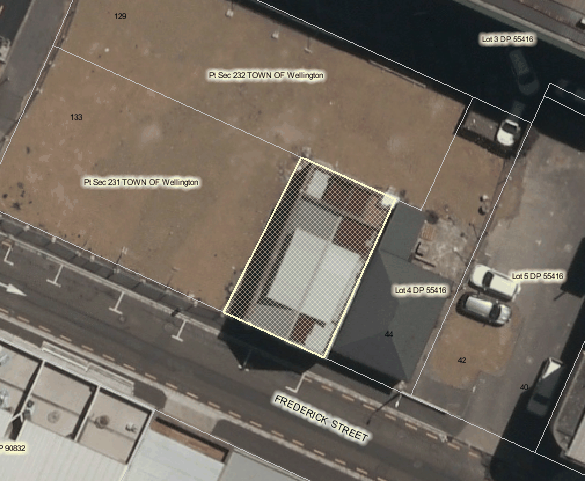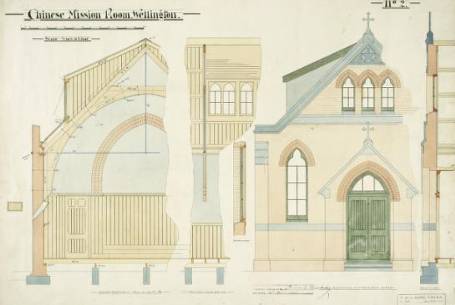Chinese Mission Hall

Image: WCC - Charles Collins, 2015


National Library reference: Clere, Frederick de Jersey, 1856-1952. Clere, Frederick de Jersey 1856-1952 :Chinese Mission room, Wellington 1905. Ref: Plans-80-0866. Alexander Turnbull Library, Wellington, New Zealand.
http://natlib.govt.nz/records/22902204-
Constructed
1905
-
-
Architect(s)
-
Builder(s)
-
A Gothic Revival style church and one of two buildings associated with Wellington’s Chinese community still standing in the Haining/Frederick Streets precinct – the centre of Chinese life in Wellington in the late 19th and early 20th centuries.
It’s a reminder of the Anglican Church involvement in Wellington’s Chinese community. Many Chinese who had settled in New Zealand as miners began to move to the cities in the 1880s.
-
Downloadable(s)
-
close
History
-
The Chinese Mission Hall is one of the few remaining buildings associated with the early Chinese settlement in Wellington which was concentrated in the Frederick Street and Haining Street area. This local ‘Chinatown’ was considered an area of dubious reputation, with its many small cottages separated by narrow alleyways. The houses of Frederick Street, however, were of a better quality that those of Haining Street. Along with Chinese grocery stores the street was also home to pakapoo gambling dens.
The Chinese Mission Hall is a tangible reminder of the work that the Anglican Church undertook in the Chinese community in Wellington. In the 1880s, with the goldfields no longer offering substantial finds, many Chinese who had originally settled in New Zealand as miners began to move to the cities.
The foundation stone of the Chinese Mission Hall was laid in 1905. The inscription reads:
To the glory of God and the spread of His kingdom among the Chinese in this diocese this stone was laid by Frederick, Bishop of Wellington, December 6th 1905.
The architect of the building was Frederick de Jersey Clere, a noted designer of ecclesiastical buildings whose motto was: Designed in beauty, built in truth. In 1883 he was appointed Diocesan Architect of the Anglican Church. Recognising the danger posed by earthquakes and fire, Clere attempted to minimise these risks by designing the church as a wooden skeleton surrounded by brick.
After fifty years of occupancy, the Anglican Chinese Mission eventually moved from Frederick Street. The hall was then purchased in 1956 by Ross Murdoch who owned the next door factory which produced Murdoch’s Anglo-Indian chutney.
From 2009 to 2012 the building, known as Fred’s, was used as a venue for gigs and exhibitions held by the Frederick Street Sound and Light Exploration Society. It is presently (2012) vacant.
-
Modifications
close
-
1905
-
Mission Hall (00053:123:6848)
-
2003
-
Seismic strengthening of hall (00078:1352:102470)
-
-
Occupation History
close
-
1905
-
Chinese Mission Trust
-
1956
-
Purchased by A. Murdoch – occupancy unclear/unknown. Further research required.
-
2009
-
Frederick Street Sound and Light Exploration Society
-
2012
-
Vacant
-
-
-
close
Architectural Information
-
Building Classification(s)
close
Not assessed
-
Architecture
close
The Chinese Mission Hall has been designed in the plainest of Gothic Revival styles. The Frederick Street facade consists of a simple gabled parapet of moderate pitch, echoed by a smaller, slightly projecting gable over the central door. The facade is symmetrical, with lancet windows flanking the door, and three smaller lancet windows under the main gable.
This plain, utilitarian design has minimal decoration; the sole flourish is a five-pointed star in the apex of the gable. The front door has a simple fanlight above. The building was clearly intended to double as a place of worship and a meeting hall, and the interior reflects the simplicity of the facade, with a tiny stepped sanctuary at one end. The roof over the hall incorporates a clerestory of pivoted lancet windows, four on each side. The exterior brickwork is English bond, and has not been plastered.
-
Materials
close
Double-cavity brick walls on concrete foundations.
Internal joinery in the hall’s chancel and porch is rimu.
Ground floor joists and exterior joinery are heart totara.
-
Setting
close
Frederick Street is a narrow street, lined on both sides with a varied collection of light industrial, commercial and residential buildings of no particular distinction. However the Chinese Mission Hall building stands apart from its surroundings due to its Gothic Revival architecture. The rear and west elevations of the building are now visible since the adjacent Murdoch’s Building has been demolished. Along with the Chinese Masonic Society Building (27 Frederick Street), the building has a historic link to the Chinese community, now dispersed. It therefore is a reminder of the former character in this part of the city.
-
Building Classification(s)
close
-
close
Cultural Value
Built in 1905 and designed by Frederick de Jersey Clere, this building has architectural value as a Gothic Revival style church.
The building has historic value as one of just two buildings associated with Wellington’s Chinese community still standing in the Haining/Frederick Streets precinct, once the centre of Chinese life in Wellington in the late 19th and early 20th centuries. .
The building has authenticity as its façade has retained a significant amount of its original fabric.
-
Aesthetic Value
close
-
Architectural
Does the item have architectural or artistic value for characteristics that may include its design, style, era, form, scale, materials, colour, texture, patina of age, quality of space, craftsmanship, smells, and sounds?
The building is designed in the Gothic Revival style by Frederick de Jersey Clere and features an interesting composition on its façade.
-
Group
Is the item part of a group of buildings, structures, or sites that taken together have coherence because of their age, history, style, scale, materials, or use?
Along with 27 Frederick Street (Chinese Masonic Society Building), the Chinese Mission Hall is one of the few buildings that still remain from the period of Chinese occupation of Frederick and Haining Streets.
-
Townscape
Does the item have townscape value for the part it plays in defining a space or street; providing visual interest; its role as a landmark; or the contribution it makes to the character and sense of place of Wellington?
This building has townscape value as its Gothic Revival architecture is a significant contrast with the surrounding buildings.
-
-
Historic Value
close
-
Association
Is the item associated with an important historic event, theme, pattern, phase, or activity?
The building is historically associated with the establishment and development of Wellington’s Chinese community.
-
Association
Is the item associated with an important person, group, or organisation?
The building is historically associated with the Anglican Church and the missionary work it undertook amongst the early Chinese community of Wellington. The building is also associated with its architect Frederick de Jersey Clere who designed over 100 churches for the Wellington Anglican diocese.
-
-
Scientific Value
close
-
Archaeological
Does the item have archaeological value for its ability to provide scientific information about past human activity?
The building is located in the Central City archaeological site reference NZAA R27/270.
-
Technological
Does the item have technological value for its innovative or important construction methods or use of materials?
The building has technological value as it was designed as a wooden skeleton surrounded by brick which de Jersey Clere hoped would minimise the risk posed by fire and earthquakes.
-
-
Social Value
close
-
Identity/Sense of place/Continuity
Is the item a focus of community, regional, or national identity? Does the item contribute to sense of place or continuity?
The building was once a focus of identity for Wellington’s Chinese community.
-
Sentiment/Connection
Is the item a focus of community sentiment and connection?
Since the Mission Hall is one of only two remaining buildings that are connected with the Chinese settlement in the area of Frederick and Haining Streets it will retain sentimental value to the descendents of Wellington’s early Chinese settlers.
-
Symbolic, commemorative, traditional, spiritual
Does the item have symbolic, commemorative, traditional, spiritual or other cultural value for the community who has used and continues to use it?
The building has spiritual and symbolic value to Chinese Anglicans since it was used to help spread Christianity within Wellington’s early Chinese community. As a hall that was also used as a church, the building has been the venue for many religious ceremonies. The building will also have cultural value to Wellington’s Chinese community since it is one of only two remaining buildings that are connected with the Chinese settlement in the area of Frederick and Haining Streets.
-
-
Level of Cultural Heritage Significance
close
-
Authentic
Does the item have authenticity or integrity because it retains significant fabric from the time of its construction or from later periods when important additions or modifications were carried out?
The building has significant authenticity as its façade appears to have remained unaltered.
-
Rare
Is the item rare, unique, unusual, seminal, influential, or outstanding?
The building, along with 27 Frederick Street, is a rare surviving example of the buildings which were formerly found on Frederick Street when it was an area of Chinese settlement.
-
Local/Regional/National/International
Is the item important for any of the above characteristics at a local, regional, national, or international level?
The building has local value in its historic role as a focus for Wellington’s Chinese community.
-
-
Local / Regional / National / International Importance
close
Not assessed
-
Aesthetic Value
close
-
close
Site Detail
-
District Plan Number
16/ 124 (front facade)
-
Legal Description
Lot 1 DP 7326 (2001 Inventory), PT SEC 231 TOWN OF WELLINGTON (Cityview)
-
Heritage New Zealand Listed
Not listed
-
Archaeological Site
Central City NZAA R27/270
-
Current Uses
unknown
-
Former Uses
unknown
-
Has building been funded
No
-
Funding Amount
Not applicable
-
Earthquake Prone Status
124 Notice
-
-
close
Additional Information
-
Sources
close
- Evening Post. Volume LXXXV, Issue 114. 15 May 1913. Page 2.
- Evening Post. Volume LXXXVII, Issue 137. 11 June 1914. Page 8.
- Manying, Ip. ‘Chinese - Later settlement.’ Te Ara - the Encyclopedia of New Zealand. updated 26-Feb-10 URL: http://www.TeAra.govt.nz/en/chinese/3. Accessed 9 August 2012
- McGill, David and Grant Till. Cityscapes. Wellington: Methuen Publishing 1977.
- New Zealand Historic Places Trust Professional Biographies.Frederick de Jersey Clere. Accessed 2 August 2012.
- Wellington City Council. “40-46 Frederick Street.” Wellington Heritage Building Inventory 2001: Non-Residential Buildings. Wellington City Council, 2001. FRED 2.
- Technical Documentation close
-
Footnotes
close
Not available
-
Sources
close
Last updated: 4/20/2017 3:03:24 AM
